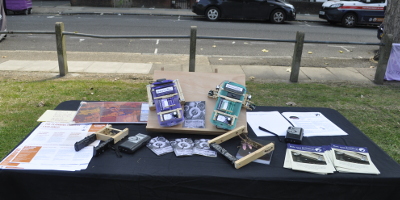
Common Ground was a free festival bringing together local community initiatives and activists, held one bright sunny day on Middleton Green in East London. It was organised by Common House, Phytology and Teeside & Hollybush TRA. I was lucky enough to be able to present my work at the festival - through a stall during the day and a walk at night.
A day at the festival

The day was great fun. I had the pleasure of being next to the wonderful North East London Migrant Action (NELMA), who were promoting their campaign for Free School Meals campaign.
My stall was laid out with bat detectors, my high frequency rattles, explanatory leafleats, a zine explaining the project - and of course the datasniffers. It is always great to discuss the Nightsniffing project with new people. I found it easiest to explain the project as expanding the idea of bat walking - as well as looking for and finding bats, we’d encounter planning applications which would indicate how space is changing. From there, we could discuss the relationship between bats, ourselves, and changes in space. Many people seemed to get the project, though I definitely left at least one person pretty confused!
And a night walk
For the evening, I organised a short bat walk, a small jaunt round the block before visiting Middleton Green and Bethnal Green Nature Reserve. Around seven people attended - this was a near ideal number as it meant most people could have a bat detector or a datasniffer.
Unlike my previous trial of the datasniffers, the walk had a determined route that meant everyone stayed together. While it can be positive to allow people explore freely, this way everyone participated in both search for bats and datasniffing. There was an interesting moment when everyone gathered around the datasniffer, and discussed what the planning application might be. One person brought up the possibility of it being an application for “in-filling” (which I understand to mean building on open space), which lead to further discussion about the effects this practice was having in the area.
The bats were out as well - a few pipistrelles around the tree in Middleton Green, and one briefly in Bethnal Green Nature Reserve as well.
A question came up once again as to whether we could actually collect data on bats during these walks. There seems to be a real desire for the walk not just to explore these ecologies and decision making processes, but feed back into them. Creating a process to record and effectively feedback the bat data might make the activity far more meaningful to those attending the walks.
 London Development Datasniffer
Revealing opaque systems of governance on your local bat walk
London Development Datasniffer
Revealing opaque systems of governance on your local bat walk